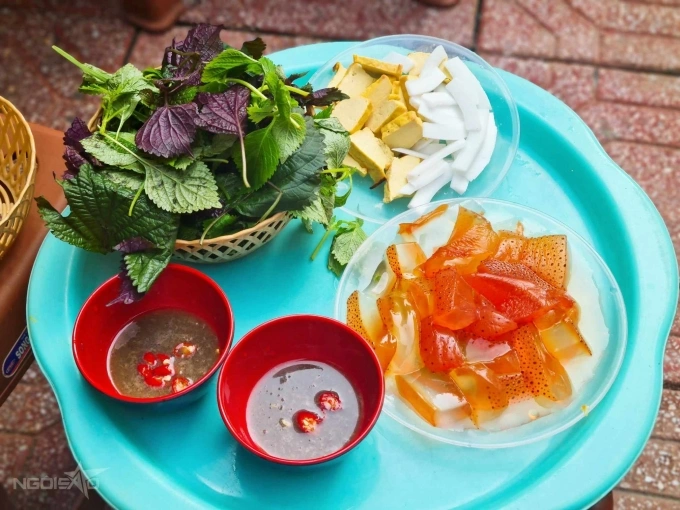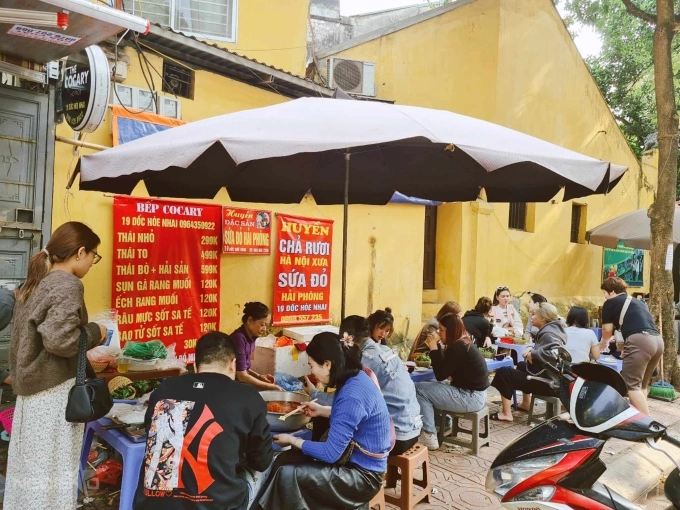Edition: International | Vietnamese
© Copyright 1997 VnExpress.net. All rights reserved.
 |
|
Red jellyfish is often served with herbs, tofu, copra, and shrimp paste. Photo by VnExpress/Nguyen Chi |
In Hanoi, the locals enjoy eating food that matches the seasons. Similar to how the 9th and 10th lunar months mark the time for cha ruoi (ragworm omelet), the second lunar month (ending April 8) signifies the prevalence of red jellyfish.
Even though this dish did not originally come from Hanoi, chefs in the capital added local ingredients to it, making it a special food that reflects the changing seasons.
Unlike its origins from the nearby Hai Phong City and Nam Dinh Province, the Hanoi version pairs the jellyfish with grilled tofu, copra slices, vegetables, and shrimp paste.
Perilla and marjoram leaves, large enough to wrap around the jellyfish, add an extra flavor.
Before eating, a squeeze of kumquat and a touch of chili is added to the shrimp paste for a flavor boost. This dipping sauce complements the crunchiness of jellyfish, harmonizing with the creaminess of tofu and copra, and the aromatic essence of perilla leaves.
 |
|
To enjoy, one can place a piece of jellyfish on a perilla leaf along with other toppings. Photo by VnExpress/Nguyen Chi |
The jellyfish itself has a dark red or orange color because it is soaked in a mixture of roots and bark from bruguiera, a type of mangrove. Then, kumquat slices are added to remove any unpleasant smell. These jellyfish are stored in large containers, waiting to be served to customers.
Preparing red jellyfish is a simple affair, mainly involving soaking it in water, without boiling or cooking it. This method is called Hanoi-style sashimi by younger people. When eaten, it goes well with perilla leaves, similar to how sashimi is enjoyed in Japanese cuisine.
Opinions about red jellyfish vary widely. Some find its taste unappealing, comparing it to a combination of a jelly-like meat with shrimp paste, and it might not be suitable for those with sensitive stomachs.
However, for those who love it, they eagerly anticipate its availability after the Lunar New Year. Missing out on red jellyfish means a year-long wait for the next jellyfish season to savor the delicacy.
Red jellyfish vendors typically operate without formal establishments, only available for a few weeks each year.
 |
|
A vendor selling red jellyfish on Hoe Nhai Street in Ba Dinh District, Hanoi. Photo by VnExpress/Nguyen Chi |
In Hanoi, finding places that serve this dish can be challenging. Apart from well-known areas like Hang Chieu and Duong Thanh streets, a small shop on Hoe Nhai Street has become more popular in recent times. The shop serves ragworm omelet rolls at the year's end and red jellyfish after Tet. Customers often enjoy their meals while seated on the sidewalk, immersing themselves in the ambiance of Hanoi.
Located at 19 Hoe Nhai Street, the restaurant is staffed mainly by elderly family members. The service is fast, ensuring customers face minimal wait times.
Red jellyfish is perfect for a free afternoon snack, as it requires time to enjoy fully. A serving typically costs VND30,000-40,000 (US$1.20-1.60).
How to eat red jejjyfish, Hanoi style. Video by VnExpress/Nguyen Chi